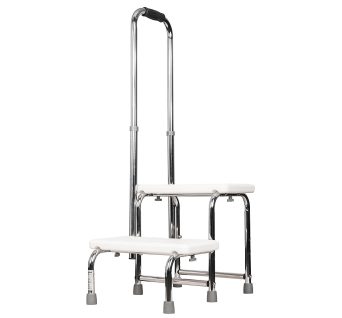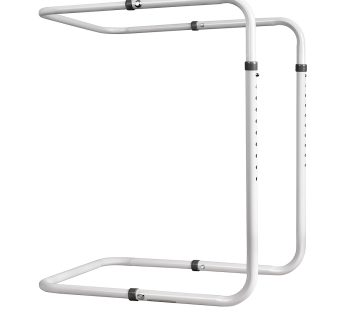-
×
 Two Step Stool with Handrail
1 × $129
Two Step Stool with Handrail
1 × $129 -
×
 Bed Blanket Support Cradle
1 × $49.99
Bed Blanket Support Cradle
1 × $49.99
Subtotal: $178.99
Showing all 8 resultsSorted by popularity
Heavy duty walking stick with Derby handle. Confident support up to 175kg.
Bariatric walking cane, height adjustable, light weight aluminium. A heavy duty walking cane to provide additional stability were and when needed.
4-point walking cane with wide footprint and large rubber ferrules.
This exceptional sturdy Rebotec Quadro – Stable 4 Point Walking Cane gives greater balance and weight distribution than a standard walking cane. Its 4-point base features interdependent rubber ferrules for improved grip on various surfaces.
With a secure rubber handle and contoured neck, it can be comfortably used by those with limited strength in their hands or hands that tire easily.
Height adjustable, folding walking stick with derby handle. your perfect companion for stability, support, and style on the move.
Crafted with aircraft grade aluminium, this walking stick combines durability with practicality. Its foldable design allows for easy storage and portability, making it an ideal choice for travel, daily errands, or outdoor adventures. The collapsible feature ensures convenience without compromising on reliability.
The ergonomic Derby handle offers a comfortable grip, reducing strain on your hand and wrist. Whether you need a reliable walking aid for stability or simply seek added support during walks, this stick provides the balance you need.
Adjustable height settings cater to your individual comfort, allowing you to find the perfect fit for your stature. Its sleek and classic design, coupled with a sturdy build, makes it both functional and visually appealing.
Walking sticks and walking canes are mobility aids designed to provide support and stability to individuals who may have difficulty walking or maintaining balance. They can be helpful for people with various mobility challenges, including those recovering from injuries, dealing with chronic conditions, or simply needing assistance with balance and stability. Here's an overview of walking sticks and walking canes:
Walking Sticks:
Walking Canes:
Choosing the Right Option: When deciding between a walking stick and a walking cane, consider the following factors:
Purpose and Usage: If you need support primarily for outdoor activities or walking on uneven terrain, a walking stick (hiking pole) might be more suitable. If you require support for everyday walking and balance, a walking cane is likely a better choice.
Stability: Canes generally offer more stability than walking sticks due to their design and contact with the ground. Quad canes, in particular, provide enhanced stability.
Comfort: Test the grip and handle of the walking stick or cane to ensure it's comfortable for you to hold. Ergonomically designed handles can reduce strain on the hand and wrist.
Height Adjustment: Make sure the walking stick or cane can be adjusted to the correct height for your body, which typically means that your elbow should be slightly bent when holding the handle.
Terrain: Consider the types of surfaces you'll be walking on. Walking sticks may be better for trails or uneven terrain, while canes can work well on sidewalks and indoor surfaces.
Healthcare Professional Advice: If you have specific mobility needs or health concerns, consult with a healthcare professional or physical therapist before making a decision. They can recommend the most appropriate option for your situation.
Both walking sticks and walking canes can provide valuable assistance for individuals seeking improved mobility and balance. It's important to choose the option that best suits your needs and enhances your safety and comfort while walking.
Choosing the right handle for your walking stick is important for comfort, support, and ease of use. Walking stick handles come in various shapes, materials, and designs, each offering different benefits. The choice of handle depends on your personal preferences, hand grip, and any specific mobility needs you may have. Here are some common types of walking stick handles to consider:
Standard Crook Handle: This is a classic and commonly used handle design. The crook handle provides a secure grip and can be easily hooked over your arm or a table when not in use. It's suitable for individuals who want a simple and functional handle.
Derby Handle: The derby handle features a smooth, ergonomic design that fits comfortably in the hand. It offers good support and distributes weight evenly on the hand. The curved design helps reduce pressure on the wrist and allows for various gripping positions. Suitable for individuals with arthritis or wrist discomfort.
Fritz Handle: The fritz handle has an ergonomic design that offers a comfortable grip and helps distribute weight evenly. It provides a larger surface area for the hand, making it suitable for individuals with larger hands or those seeking extra support.
Orthopedic Handle: Orthopedic handles are specially designed to accommodate specific hand conditions and reduce strain. They come in various shapes and sizes, tailored to individual needs. Orthopedic handles are recommended for people with hand issues such as arthritis or joint pain.
Ergonomic Handles: Ergonomically designed handles are contoured to fit the natural shape of the hand, reducing strain and pressure. They are suitable for individuals who require extra comfort and support during prolonged use.
Palm Grip Handle: The palm grip handle has a wide, flat design that rests comfortably in the palm of the hand. It provides excellent support and stability, making it a good choice for users who require a strong grip.
Offset Handle: Offset handles are angled to align with the user's wrist and provide a more natural hand position. They help distribute weight evenly and are often used by individuals with balance issues.
When choosing a handle, consider trying out different options to determine which one feels most comfortable and supportive for your grip. If you have specific hand or wrist conditions, consult with a healthcare professional or an occupational therapist for guidance on selecting the right handle design to meet your needs.
When using a walking stick, it's generally recommended to hold it on the side opposite your weaker or affected leg. This technique helps provide better support, stability, and balance. Here's a more detailed explanation:
Hold on the Opposite Side: If your right leg is weaker or affected, hold the walking stick in your left hand. If your left leg is weaker, hold the walking stick in your right hand. This allows you to shift some weight off the weaker leg and onto the walking stick, providing additional support and stability.
Supporting the Weaker Side: Holding the walking stick on the opposite side helps you support your weaker leg as you walk. When you take a step with your weaker leg, you can lean on the walking stick to help bear some of your body weight and maintain better balance.
Even Gait and Balance: Using the walking stick on the opposite side encourages a more even and balanced gait. It helps reduce the risk of limping or overloading the stronger leg, which could lead to discomfort or further imbalance.
Natural Arm Swing: Holding the walking stick on the opposite side of your weaker leg allows for a more natural arm swing as you walk. This helps maintain a smoother and more coordinated walking pattern.
It's important to note that while the general guideline is to hold the walking stick on the opposite side of your weaker leg, individual circumstances may vary. If you have specific mobility challenges, injuries, or medical conditions, it's advisable to consult with a healthcare professional, such as a physical therapist or an occupational therapist. They can assess your unique needs and provide personalized recommendations for the best way to use a walking stick to enhance your mobility and safety.